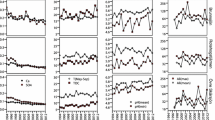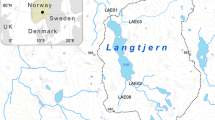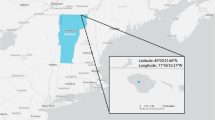Abstract
Honnedaga Lake in the Adirondack region of New York has sustained a heritage brook trout population despite decades of atmospheric acid deposition. Detrimental impacts from acid deposition were observed from 1920 to 1960 with the sequential loss of acid-sensitive fishes, leaving only brook trout extant in the lake. Open-lake trap net catches of brook trout declined for two decades into the late 1970s, when brook trout were considered extirpated from the lake but persisted in tributary refuges. Amendments to the Clean Air Act in 1990 mandated reductions in sulfate and nitrogen oxide emissions. By 2000, brook trout had re-colonized the lake coincident with reductions in surface-water sulfate, nitrate, and inorganic monomeric aluminum. No changes have been observed in surface-water acid-neutralizing capacity (ANC) or calcium concentration. Observed increases in chlorophyll a and decreases in water clarity reflect an increase in phytoplankton abundance. The zooplankton community exhibits low species richness, with a scarcity of acid-sensitive Daphnia and dominance by acid-tolerant copepods. Trap net surveys indicate that relative abundance of adult brook trout population has significantly increased since the 1970s. Brook trout are absent in 65 % of tributaries that are chronically acidified with ANC of <0 μeq/L and toxic aluminum levels (>2 μmol/L). Given the current conditions, a slow recovery of chemistry and biota is expected in Honnedaga Lake and its tributaries. We are exploring the potential to accelerate the recovery of brook trout abundance in Honnedaga Lake through lime applications to chronically and episodically acidified tributaries.






Similar content being viewed by others
References
Anderson, D. R. (2008). Model based inference in the life sciences: a primer on evidence. New York: Springer.
Baker, J. P., & Christensen, S. W. (1991). Effects of acidification on biological communities in aquatic ecosystems. In D. F. Charles (Ed.), Acidic deposition and aquatic ecosystems: regional case studies (pp. 83–106). New York: Springer-Verlag.
Baker, J. P., Van Sickle, J., Gagen, C. J., DeWalle, D. R., Sharpe, W. E., Carline, R. F., Baldigo, B. P., Murdoch, P. S., Bayh, D. W., Kretser, W. A., Simonin, H. A., & Wigington, P. J. (1996). Episodic acidification of small streams in the northeastern United States: effects on fish populations. Ecological Applications, 6(2), 422–437.
Baldigo, B. P., & Murdoch, P. S. (1997). Effect of stream acidification and inorganic aluminum on mortality of brook trout (Salvelinus fontinalis) in the Catskill Mountains, New York. Canadian Journal of Fisheries and Aquatic Sciences, 54, 603–615.
Baldigo, B. P., Lawrence, G., & Simonin, H. (2007). Persistent mortality of brook trout in episodically acidified streams of the southwestern Adirondack Mountains, New York. Transactions of the American Fisheries Society, 136, 121–134.
Biro, P. A. (1998). Staying cool: behavioral thermoregulation during summer by young- of-the-year brook trout in a lake. Transactions of the American Fisheries Society, 127, 212–222.
Borwick, J., Buttle, J., & Ridgeway, M. S. (2006). A topographic index approach for identifying groundwater habitat of young-of-year brook trout (Salvelinus fontinalis) in the land–lake ecotone. Canadian Journal of Fisheries and Aquatic Sciences, 63, 239–253.
Burnham, K. P., & Anderson, D. R. (2002). Model selection and multimodel inference: a practical information-theoretic approach (2nd ed.). New York: Springer.
Burns, D. A. (2011). National acid precipitation assessment program report to Congress 2011: an integrated assessment. Washington, D.C: National Science and Technology Council.
Confer, J. L., Kaaret, T., & Likens, G. E. (1983). Zooplankton diversity and biomass in recently acidified lakes. Canadian Journal of Fisheries and Aquatic Sciences, 40, 36–42.
Curry, R. A., Brady, C., Noakes, D. L. G., & Danzmann, R. G. (1997). Use of small streams by young brook trout spawned in a lake. Transactions of the American Fisheries Society, 126, 77–83.
Doka, S. E., McNicol, D. K., Mallory, M. L., Wong, I., Minns, C. K., & Yan, N. D. (2003). Assessing potential for recovery of biotic richness and indicator species due to changes in acidic deposition and lake pH in five areas of southeastern Canada. Environmental Monitoring and Assessment, 88, 53–101.
Driscoll, C. T., Newton, R. M., Gubala, C. P., Baker, J. P., & Christensen, S. (1991). Adirondack mountains. In D. F. Charles (Ed.), Acidic deposition and aquatic ecosystems: regional case studies (pp. 133–202). New York: Springer-Verlag.
Driscoll, C. T., Lawrence, G. B., Bulger, A. J., Butler, T. J., Cronan, C. S., Eagar, C., Lambert, K. F., Likens, G. E., Stoddard, J. L., & Weathers, K. C. (2001). Acidic deposition in the Northeastern United States: Sources and inputs, ecosystem effects, and management strategies. BioScience, 51, 180–198.
Driscoll, C. T., Driscoll, K. M., Mitchell, M. J., & Raynal, D. J. (2003a). Effects of acidic deposition on forest and aquatic ecosystems in New York State. Environmental Pollution, 123, 327–336.
Driscoll, C. T., Driscoll, K. M., Roy, K. M., & Mitchell, M. J. (2003b). Chemical response of lakes in the Adirondack region of New York to declines in acidic deposition. Environmental Science and Technology, 37, 2036–2042.
Driscoll, C. T., Driscoll, K. M., Roy, K. M., & Dukett, J. (2007). Changes in the chemistry of lakes in the Adirondack region of New York following declines in acidic deposition. Applied Geochemistry, 22, 1181–1188.
Evans, C. D., Monteith, D. T., & Cooper, D. M. (2005). Long-term increases in surface water dissolved organic carbon: observations, possible causes and environmental impacts. Environmental Pollution, 137, 55–71.
Fischer, J. M., Klug, J. L., Ives, A. R., & Frost, T. M. (2001). Ecological history affects zooplankton community responses to acidification. Ecology, 82, 2984–3000.
Frost, T. M., Montz, P. K., & Kratz, T. K. (1998). Zooplankton community responses during recovery from acidification: limited persistence by acid-favoured species in Little Rock Lake, Wisconsin. Restoration Ecology, 6, 336–342.
Fryer, G. (1993). Variation in acid tolerance of certain freshwater crustaceans in different natural waters. Hydrobiologia, 250, 119–125.
Havas, M., & Likens, G. E. (1985). Changes in 22Na influx and outflux in Daphnia magna (Straus) as a function of elevated Al concentrations in soft water at low pH. Proceedings of the National Academy of Sciences of the United States of America, 82, 7345–7349.
Havas, M., & Rosseland, B. O. (1995). Response of zooplankton, benthos, and fish to acidification: an overview. Water, Air, and Soil Pollution, 85, 51–62.
Havens, K. E., & Heath, R. T. (1989). Acid and aluminum effects on freshwater zooplankton: an in situ mesocosm study. Environmental Pollution, 62, 195–211.
Havens, K. E., Yan, N. D., & Keller, W. (1993). Lake acidification: effects on crustacean zooplankton populations. Environmental Science and Technology, 27, 1621–1624.
Holt, C. A., Yan, N. D., & Somers, K. M. (2003). pH 6 as the threshold to use in critical load modeling for zooplankton community change with acidification in lakes of south-central Ontario: accounting for morphometry and geography. Canadian Journal of Fisheries and Aquatic Sciences, 60, 151–158.
Ito, M., Mitchell, M. J., & Driscoll, C. T. (2002). Spatial patterns of precipitation quantity and chemistry and air temperature in the Adirondack region of New York. Atmospheric Environment, 36, 1051–1062.
Jenkins, J., Roy, K., Driscoll, C., & Buerkett, C. (2005). Acid rain and the Adirondacks: a research summary. Ray Brook (NY): Adirondack Lakes Survey Corporation.
Keller, W. T. (1979). Management of wild and hybrid brook trout in New York lakes, ponds and coastal streams. Albany: New York State Department of Environmental Conservation.
Keller, W., & Pitblado, J. R. (1984). Crustacean plankton in northeastern Ontario lakes subjected to acid deposition. Water, Air, and Soil Pollution, 23, 271–291.
Keller, W., & Yan, N. D. (1998). Biological recovery from acidification: zooplankton communities as a model of patterns and processes. Restoration Ecology, 6, 364–375.
Keller, W., Yan, N. D., Somers, K. M., & Heneberry, J. H. (2002). Crustacean zooplankton communities in lakes recovering from acidification. Canadian Journal of Fisheries and Aquatic Sciences, 59, 726–735.
Kretser, W., Gallagher, J., & Nicolette, J. (1989). Adirondack Lakes Study 1984–1987: an evaluation of fish communities and water chemistry. Ray Brook (NY): Adirondack Lakes Survey Corporation.
Lawrence, G. B. (2002). Persistent episodic acidification of streams linked to acid rain effects on soil. Atmospheric Environment, 36, 1589–1598.
Lawrence, G. B., Lincoln, T., Horan-Ross, D. A., Olson, M. L., Waldron, L. A. (1995). Analytical methods of the U.S. Geological Survey’s New York District water-analysis laboratory; U.S. Geological Survey: Reston, VA.
Lawrence, G. B., Roy, K. M., Baldigo, B. P., Simonin, H. A., Capone, S. B., Sutherland, J. W., Nierzwicki-Bauer, S. A., & Boylen, C. W. (2008). Chronic and episodic acidification of Adirondack streams from acid rain in 2003–2005. Journal of Environmental Quality, 37, 2264–2274.
Marmorek, D. R., & Korman, J. (1993). The use of zooplankton in a biomonitoring program to detect lake acidification and recovery. Water, Air, and Soil Pollution, 69, 223–241.
Menard, S. (2001). Applied logistic regression analysis. SAGE University Papers Series 07-106. Thousand Oaks: SAGE.
Momen, B., Lawrence, G. B., Nierzwicki-Bauer, S. A., Sutherland, J. W., Eichler, L. W., Harrison, J. P., & Boylen, C. W. (2006). Trends in summer chemistry linked to productivity in lakes recovering from acid deposition in the Adirondack region of New York. Ecosystems, 9, 1306–1317.
Monteith, D. T., Hildrew, A. G., Flower, R. J., Raven, P. J., Beaumont, W. R. B., Collen, P., Kreiser, A. M., Shilland, E. M., & Winterbottom, J. H. (2005). Biological responses to the chemical recovery of acidified fresh waters in the UK. Environmental Pollution, 137, 83–101.
Monteith, D. T., Stoddard, J. L., Evans, C. D., de Wit, H. A., Forsius, M., Hogasen, T., Wilander, A., Skjelkvale, B. L., Jeffries, D. S., Vuorenmaa, J., Keller, B., Kopacek, J., & Vesely, J. (2007). Dissolved organic carbon trends resulting from changes in atmospheric deposition chemistry. Nature, 450, 537–539.
Newton, R.M., and C.T. Driscoll. (1990). Classification of ALSC lakes. In: Adirondack lakes survey: an interpretive analysis of fish communities and water chemistry. 1984–1987. (pp 2–70, 72–91) Adirondack Lakes Survey Corporation: Ray Brook (NY).
Nierzwicki-Bauer, S. A., Boylen, C. W., Eichler, L. W., Harrison, J. P., Sutherland, J. W., Shaw, W., Daniels, R. A., Charles, D. F., Acker, F. W., Sullivan, T. J., Momen, B., & Bukaveckas, P. (2010). Acidification in the Adirondacks: defining the biota in trophic levels of 30 chemically diverse acid-impacted lakes. Environmental Science and Technology, 44, 5721–5727.
Price, E. E., & Swift, M. C. (1985). Inter- and intra-specific variability in the response of zooplankton to acid stress. Canadian Journal of Fisheries and Aquatic Sciences, 42, 1749–1754.
Roff, J. C., & Kwiatkowski, R. E. (1977). Zooplankton and zoobenthos communities of selected northern Ontario lakes of different acidities. Canadian Journal of Zoology, 55, 899–911.
Schofield, C. L. (1965). Water quality in relation to survival of brook trout, Salvelinus fontinalis (Mitchill). Transactions of the American Fisheries Society, 94(3), 227–235.
Schofield, C. L. (1976). Acid precipitation: effects on fish. Ambio, 5, 228–230.
Schofield, C. L., & Driscoll, C. T. (1987). Fish species distribution in relation to water quality gradients in the north branch of the Moose River basin. Biogeochemistry, 3, 63–85.
Siegfried, C. A., & Sutherland, J. W. (1992). Zooplankton communities of Adirondack lakes: changes in community structure associated with acidification. Journal Freshwater Ecology, 7, 97–112.
Sprules, W. G. (1975). Midsummer crustacean zooplankton communities in acid- stressed lakes. Journal of the Fisheries Research Board of Canada, 32, 389–395.
Stevens, P.M. (2008). Topographic index modeling of young-of-year brook trout (Salvelinus fontinalis) habitat and selecting candidate lakes for wild brook trout re-introduction. Master’s thesis. Cornell University, Ithaca.
Stoddard, J. L., Kahl, J. S., Deviney, F. A., DeWalle, D. R., Driscoll, C. T., Herlihy, A. T., Kellogg, J. H., Murdoch, P. S., & Webb, J. R. (2003). Air Act Amendments of 1990. Washington, DC: U.S. Environmental Protection Agency.
Sullivan, T. J., Cosby, B. J., Herlihy, A. T., Driscoll, C. T., Fernandez, I. J., McDonnell, T. C., Boylen, C. W., Nierzwicki-Bauer, S. A., & Snyder, K. U. (2007). Assessment of the extent to which intensively-studied lakes are representative of the Adirondack region and response to future changes in acidic deposition. Water, Air, and Soil Pollution, 185, 279–291.
Swets, J. A. (1988). Measuring the accuracy of diagnostic systems. Science, 240, 1285–1293.
Tipping, E., Bass, J. A. B., Hardie, D., Haworth, E. Y., Hurley, M. A., & Wils, G. (2002). Biological responses to the reversal of acidification in surface waters of the English Lake District. Environmental Pollution, 116, 137–146.
US Environmental Protection Agency. (1987). Handbook of methods for acid deposition studies: laboratory analysis for surface water chemistry. EPA/600/4-87/026. Washington, D.C: U.S. Environmental Protection Agency, Office of Research and Development.
Van Sickle, J., Baker, J. P., Simonin, H. A., Baldigo, B. P., Kretser, W. A., & Sharpe, W. E. (1996). Episodic acidification of small streams in the northeastern United States: fish mortality in field bioassays. Ecological Applications, 6(2), 408–421.
Venne, H., & Magnan, P. (1995). The impact of intra and interspecific interactions on young-of-the-year brook charr, in temperate lakes. Journal of Fish Biology, 46, 669–686.
Vrba, J., Kopáček, J., Bittl, T., Nedoma, J., Štrojsová, A., Nedbalová, L., Kohout, L., & Fott, J. (2006). A key role of aluminum in phosphorus availability, food web structure, and plankton dynamics in strongly acidified lakes. Biologia Bratislava, 61, S441–S451.
Vuong, Q. H. (1989). Likelihood ratio tests for model selection and non-nested hypotheses. Econometrica, 57, 307–333.
Warby, R. A. F., Johnson, C. E., & Driscoll, C. T. (2005). Chemical recovery of surface waters across the northeastern United States from reduced inputs of acidic deposition: 1984–2001. Environmental Science and Technology, 39, 6548–6554.
Webster, D. A. (1961). An unusual lake of the Adirondack Mountains, New York. Limnology and Oceanography, 6(1), 88–90.
Yan, N. D., & Strus, R. (1980). Crustacean zooplankton communities of acidic, metal-contaminated lakes near Sudbury, Ontario. Canadian Journal of Fisheries and Aquatic Sciences, 37, 2282–2293.
Acknowledgements
Assistance in the field and laboratory was provided by Cornell University staff and students including B. Weidel, S. Krueger, A. Barbato, T. Treska, M. Compton, I. Kiraly, E. Camp, L. Resseguie, M. Pepper, A. Garcia, J. Harris, and numerous other personnel. The Adirondack League Club provided access to Honnedaga Lake and member Peter Grose organized the weekly collection of tributary water samples in the summers 2008 to 2010. Funding for this project was provided by the Adirondack League Club and the Adirondack Fishery Research Fund. Chemical analysis of water samples collected from 2000 to 2011 were analyzed by the Darrin Fresh Water Institute Keck Water Quality Laboratory and the US Geological Survey Water Science Center both located in Troy, NY. G. Lawrence provided comments on an earlier version of this paper.
Author information
Authors and Affiliations
Corresponding author
Rights and permissions
About this article
Cite this article
Josephson, D.C., Robinson, J.M., Chiotti, J. et al. Chemical and biological recovery from acid deposition within the Honnedaga Lake watershed, New York, USA. Environ Monit Assess 186, 4391–4409 (2014). https://doi.org/10.1007/s10661-014-3706-9
Received:
Accepted:
Published:
Issue Date:
DOI: https://doi.org/10.1007/s10661-014-3706-9




